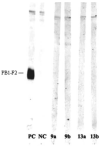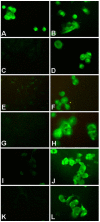Antibodies to PB1-F2 protein are induced in response to influenza A virus infection - PubMed (original) (raw)
Antibodies to PB1-F2 protein are induced in response to influenza A virus infection
Ingrid Krejnusová et al. Arch Virol. 2009.
Abstract
PB1-F2 is a small influenza A virus (IAV) protein encoded by an alternative (+1) reading frame of the PB1 gene. While dispensable for IAV replication in cultured cells, PB1-F2 has been implicated in IAV pathogenicity. To better understand PB1-F2 expression in vivo and its immunogenicity, we analyzed anti-PB1-F2 antibodies (Abs) in sera of mice infected intranasally (i.n.) with A/PR/8/34 (H1N1) virus and human acute and convalescent sera collected from the influenza H3N2 winter 2003-2004 epidemic. We explored a number of methods for detecting anti-PB1-F2 Abs, finding that PB1-F2-specific Abs could clearly be detected via immunoprecipitation or immunofluorescence assays using both immune mouse and human convalescent sera. Importantly, paired human sera exhibited similar increases in HI titers and PB1-F2-specific Abs. This study indicates that PB1-F2 is expressed in sufficient quantities in mice and humans infected with IAV to elicit an Ab response, supporting the biological relevance of this intriguing accessory protein.
Figures
Fig. 1
WB analysis of human paired sera for PB1-F2. Acute (a) and convalescent (b) human sera, MAb AG55, positive control (PC), normal mouse serum, negative control (NC)
Fig. 2
Immunoprecipitation analysis of immune mouse sera and human paired sera for PB1-F2-specific Abs. Immune mouse sera (1-10), human paired sera (4-20, acute (a), convalescent (b)), immune mouse serum to PB1-F2, positive control (PC), normal mouse serum, negative control (NC)
Fig. 3
Immunofluorescence analysis of immune mouse sera (e, f, g, h) and human convalescent sera (i, j, k, l) for PB1-F2-specific Abs. MDCK cells infected with CR19 and detected with MAb TW2.3 (a), MAb AG55 (c), immune mouse sera (e, g), and human convalescent sera (i, k), respectively. MDCK cells infected with VV-PB1-F2 and detected with MAb TW2.3 (b), MAb AG55 (d), mouse immune sera (f, h), and human convalescent sera (j, l), respectively Table 1
Similar articles
- The multifaceted effect of PB1-F2 specific antibodies on influenza A virus infection.
Košík I, Krejnusová I, Práznovská M, Russ G. Košík I, et al. Virology. 2013 Dec;447(1-2):1-8. doi: 10.1016/j.virol.2013.08.022. Epub 2013 Sep 13. Virology. 2013. PMID: 24210094 - Influenza A virus protein PB1-F2 exacerbates IFN-beta expression of human respiratory epithelial cells.
Le Goffic R, Bouguyon E, Chevalier C, Vidic J, Da Costa B, Leymarie O, Bourdieu C, Decamps L, Dhorne-Pollet S, Delmas B. Le Goffic R, et al. J Immunol. 2010 Oct 15;185(8):4812-23. doi: 10.4049/jimmunol.0903952. Epub 2010 Sep 15. J Immunol. 2010. PMID: 20844191 - Pro-inflammatory Effects of Influenza Type A Virus PB1-F2 Protein-derived Peptide in Lipopolysaccharide-treated Macrophages.
Kalantar K, Farzaneh Z, Gholijani N, Hosseini SY, Bani Hasan E. Kalantar K, et al. Iran J Allergy Asthma Immunol. 2020 May 17;19(S1):74-82. doi: 10.18502/ijaai.v19i(s1.r1).2863. Iran J Allergy Asthma Immunol. 2020. PMID: 32534514 - Influenza A virus PB1-F2 protein: An ambivalent innate immune modulator and virulence factor.
Cheung PH, Lee TT, Chan CP, Jin DY. Cheung PH, et al. J Leukoc Biol. 2020 May;107(5):763-771. doi: 10.1002/JLB.4MR0320-206R. Epub 2020 Apr 23. J Leukoc Biol. 2020. PMID: 32323899 Review. - Evolution and Virulence of Influenza A Virus Protein PB1-F2.
Kamal RP, Alymova IV, York IA. Kamal RP, et al. Int J Mol Sci. 2017 Dec 29;19(1):96. doi: 10.3390/ijms19010096. Int J Mol Sci. 2017. PMID: 29286299 Free PMC article. Review.
Cited by
- Evolutionary features of a prolific subtype of avian influenza A virus in European waterfowl.
Wille M, Tolf C, Latorre-Margalef N, Fouchier RAM, Halpin RA, Wentworth DE, Ragwani J, Pybus OG, Olsen B, Waldenström J. Wille M, et al. Virus Evol. 2022 Aug 27;8(2):veac074. doi: 10.1093/ve/veac074. eCollection 2022. Virus Evol. 2022. PMID: 36128050 Free PMC article. - Effect of 1918 PB1-F2 expression on influenza A virus infection kinetics.
Smith AM, Adler FR, McAuley JL, Gutenkunst RN, Ribeiro RM, McCullers JA, Perelson AS. Smith AM, et al. PLoS Comput Biol. 2011 Feb;7(2):e1001081. doi: 10.1371/journal.pcbi.1001081. Epub 2011 Feb 17. PLoS Comput Biol. 2011. PMID: 21379324 Free PMC article. - The ubiquitination of the influenza A virus PB1-F2 protein is crucial for its biological function.
Košík I, Práznovská M, Košíková M, Bobišová Z, Hollý J, Varečková E, Kostolanský F, Russ G. Košík I, et al. PLoS One. 2015 Apr 13;10(4):e0118477. doi: 10.1371/journal.pone.0118477. eCollection 2015. PLoS One. 2015. PMID: 25866881 Free PMC article. - Protective Antibodies Against Influenza Proteins.
Padilla-Quirarte HO, Lopez-Guerrero DV, Gutierrez-Xicotencatl L, Esquivel-Guadarrama F. Padilla-Quirarte HO, et al. Front Immunol. 2019 Jul 18;10:1677. doi: 10.3389/fimmu.2019.01677. eCollection 2019. Front Immunol. 2019. PMID: 31379866 Free PMC article. Review. - Influenza vaccination in the elderly boosts antibodies against conserved viral proteins and egg-produced glycans.
Jung J, Mundle ST, Ustyugova IV, Horton AP, Boutz DR, Pougatcheva S, Prabakaran P, McDaniel JR, King GR, Park D, Person MD, Ye C, Tan B, Tanno Y, Kim JE, Curtis NC, DiNapoli J, Delagrave S, Ross TM, Ippolito GC, Kleanthous H, Lee J, Georgiou G. Jung J, et al. J Clin Invest. 2021 Jul 1;131(13):e148763. doi: 10.1172/JCI148763. J Clin Invest. 2021. PMID: 34196304 Free PMC article.
References
- Chen W, Calvo PA, Malide D, Gibbs J, Schubert U, Bacik I, Basta S, O’Neill R, Schickli J, Palese P, Henklein P, Bennink JR, Yewdell JW. A novel influenza A virus mitochondrial protein that induces cell death. Nat Med. 2001;7:1306–1312. - PubMed
- Pančuchárová H, Russ G. PB1-F2 gene in influenza A viruses of different hemagglutinin subtype. Acta Virol. 2006;50:269–272. - PubMed
- Gocnikova H, Russ G. Influenza a virus PB1-F2 protein. Acta Virol. 2007;51:101–108. - PubMed
- Yamada H, Chounan R, Higashi Y, Kurihara N, Kido H. Mitochondrial targeting sequence of the influenza A virus PB1-F2 protein and its function in mitochondria. FEBS Lett. 2004;578:331–336. - PubMed
Publication types
MeSH terms
Substances
LinkOut - more resources
Full Text Sources
Medical
Research Materials
Miscellaneous


